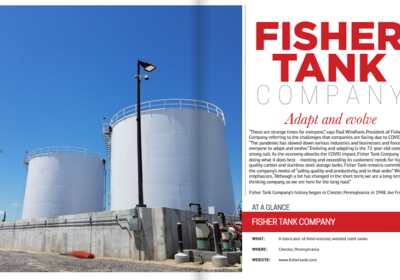5 TIPS FOR SUCCESSFUL SUBCONTRACTS

Subcontractors can be an integral part of large projects. EPC firms rely on a host of subcontractors to carry out extensive projects. Fisher builds welded steel tanks directly for project and facility owners, as well as for EPC firms and other entities. EPCs and General Contractors call on us to supply firewater tanks, fuels tanks, or other storage tanks as part of larger projects. Our own field erected tank projects often involve subcontractors who handle things like soil remediation, foundations, insulation, hydrotesting, and other aspects of the overall tank project. We work as subcontractors and we work with subcontractors, and we’ve learned that successful projects depend on clear communication and coordinated execution in all cases.
Here are some tips for start-to-finish subcontract success:
Provide The Sub With All The Info
Providing a comprehensive RFQ is essential. If the subcontractor has a crystal clear picture of what you need, it’s much easier for them to produce a proposal that’s equally clear. Are there aspects of your work that you typically subcontract? Can you identify the usual scope for things you commonly do? Working with your team to develop templates for your subcontractor requests can help streamline your bid process and ensure that you provide your potential subs with all the information they need. This is the kind of work Steven Covey calls Important (not Urgent). It’s hard to take the time to do it, but the payoff can be tremendous. When it’s time to request a quote from a sub, and you can identify the sequence of events and you can give the sub a comprehensive RFQ that outlines everything you need, you will avoid a lot of nasty surprises.
Understand The Subcontractor’s Full Scope Of Work
You say tomato, I say to-mah-to. If you are asking for a quote on Project X, and you get a proposal for Project X, it’s easy to assume that the subcontractor has offered a price on what you needed. That he/she has heard what you needed, and made a proposal according to your request. But is the proposal what you needed? Clear communication about what you need from the sub (i.e., your comprehensive RFQ) and what the sub intends to do is vital. How often do your coworkers, spouse or children hear what they think you said – not what you actually said. Or meant. A thorough review of the sub’s proposal, along with discussion about their plans for the project should be part of the process, so that everyone is absolutely clear on what work the subcontractor will perform.
Know The Sequence of Events
Knowing the sequence of events for a project will require some front-end work. It’s important to identify all of the major milestones, and the steps that will lead up to each one. When will the hand-offs occur? When will each subcontractor finish their particular scope of work, and when will new subs need to come on to the job site? From the number of workers on the site and security clearances, to lay down areas and space for vehicles, knowing what’s going to happen and when will go a long way toward avoiding delays and making efficient progress on the job. Having a clear picture of the order in which things need to happen before the job gets started helps with scheduling, but it also helps prevent unforeseen costs as the project moves forward. Visualize the sequence, put it on paper or on a white board, and get input from those involved. It worked for Michael Jordan; it can work for you.
Identify Exclusions
In addition to understanding exactly what the sub can do, and when they’ll do it, it’s essential that you know what they won’t do. Exclusions can be the bane of many project managers. Just like that awesome 50% off coupon that excludes anything you might want to buy, subcontractors’ exclusions can put a major damper on a project. If you’re getting pricing from a sub to include in your own proposal, any exclusions must be identified early on, so that you can make allowances in your bid, or seek additional resources as needed, so that you don’t end up eating the cost of doing what your sub said he wouldn’t do way back on page 19 of his proposal. The bottom line here, of course, is communication. Provide all the info you can to the sub. Read the sub’s proposal. Look for exclusions, and confirm in writing any specific needs you have that could possibly be problematic.
Investigate Pricing Differences
We bump up against this one all the time in our own proposals. Every tank we build is a custom project, and sometimes we’re providing budgetary proposals with limited information. For example, we might end up significantly higher than another tank contractor on a bid because we included cathodic protection, or insulation, or other features, based on our understanding of the project and our experience with that type of application, and the other contractor did not. Sometimes pricing differences are just a communication issue, sometimes they’re scope issue and sometimes they’re reflective of other things, but they shouldn’t be disregarded. Here’s another opportunity for communication with the subcontractor; discussing pricing difference might reveal errors, differences in interpretation of the scope, exclusions, or even issues and solutions the sub thought of that you had not considered.
Move Ahead Only When All Documentation Is In Place
We all know what happens when you assume things… Moving forward with a project before every “i” is dotted and every “t” is crossed is a recipe for disaster – or at least costs that were not in your plan. For example, we were doing some very standard API 653 repair work for a long-time customer. The work required us to fabricate a standard part that we had fabricated many times for this customer. As the project was moving forward, we began fabricating the parts in preparation for mobilizing on site and doing the tank repairs. However, we did not have the drawings in hand… When everything was signed, sealed and delivered, we saw that the customer had made a slight change to their standard design for the part we’d already fabricated. Oops. We were able to fabricate the parts correctly and stay on schedule for the customer, but it was not cost effective or efficient for us!
In addition to drawings and other project info, it’s important to have qualification information for subs in place before the project begins. Safety and licensing problems are not something you want to learn about after you’ve committed to a sub. No matter how long you’ve been working with a subcontractor, or a customer, it’s always a good idea to make sure you have all the information, and all the documentation, in place before moving forward with any part of the project.
Successful subcontracts depend on some front-end effort and on good communication throughout the process. Taking steps to establish clear communication throughout the proposal process can significantly improve the effectiveness of your projects and move your team toward success.
Looking for a tank contractor? Visit us today!
More info about working with Tank Contractors
More information about Steven Covey’s Urgent vs
Important Matrix
Click here to read more of our blogs




